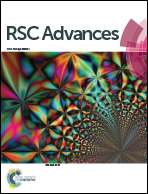Perimidine based selective colorimetric and fluorescent turn-off chemosensor of aqueous Cu2+: studies on its antioxidant property along with its interaction with calf thymus-DNA†
Abstract
We have developed a perimidine based simple and easily synthesised chemosensor, 1,3-bis(2,3-dihydro-1H-perimidin-2-yl)benzene (1), which exhibits selective colorimetric and fluorescence “turn off” response toward nano molar Cu2+. This method allows a sensitive readout of chemosensor 1 within a wide linear range of (5–2771) × 10−8 M at λmax 346 nm, and with limit of detection (LOD) 6.19 × 10−8 M. Moreover, 1 exhibits free radical scavenging ability, six times better than that of L-ascorbic acid. The binding interaction studies of 1 with calf-thymus DNA (CT-DNA) indicate a groove binding mode.



 Please wait while we load your content...
Please wait while we load your content...